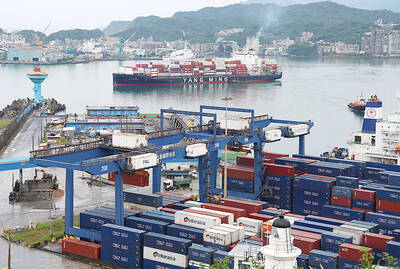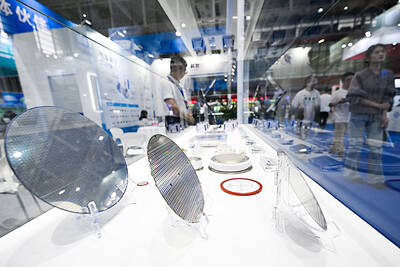US wholesale prices unexpectedly fell last month by the most since October 2023, restrained by energy costs and adding to evidence of tame inflation leading up to a wave of tariffs.
The producer price index (PPI) fell 0.4 percent from a month earlier following a revised 0.1 percent gain in February, a US Bureau of Labor Statistics report released yesterday showed.
The median forecast in a Bloomberg survey of economists called for a 0.2 percent gain.
Excluding food and energy, a measure of underlying wholesale inflation, the PPI eased 0.1 percent compared with expectations for a 0.3 percent gain.
The figures follow a bureau report on Thursday that showed consumer prices fell last month for the first time since 2020.
However, economists expect inflation to accelerate over the remainder of the year, as US President Donald Trump’s sweeping tariffs on imported goods filter through into higher prices for businesses and households.
Analysts pay close attention to the PPI, because some of its components are used to calculate the US Federal Reserve’s preferred measure of inflation that is based on the personal consumption expenditures (PCE) price index.
Those categories were generally favorable in March: airfares fell 0.4 percent and hospital services costs rose at a slower rate. The PCE report would be published later this month.
In early February, the Trump administration put in place an additional 10 percent levy on goods imported from China. Since then, in a series of announcements after retaliation by Beijing, the US president raised the total duty on Chinese goods to 145 percent.
Earlier this week, Trump announced a 90-day pause on higher tariffs on most US trading partners, opting instead for a 10 percent tariff on imports. In addition, higher duties on aluminum and steel went into effect March 12.
The overall impact on prices from these actions might show up more clearly with the release of the April PPI data next month.

Taiwan’s exports soared 56 percent year-on-year to an all-time high of US$64.05 billion last month, propelled by surging global demand for artificial intelligence (AI), high-performance computing and cloud service infrastructure, the Ministry of Finance said yesterday. Department of Statistics Director-General Beatrice Tsai (蔡美娜) called the figure an unexpected upside surprise, citing a wave of technology orders from overseas customers alongside the usual year-end shopping season for technology products. Growth is likely to remain strong this month, she said, projecting a 40 percent to 45 percent expansion on an annual basis. The outperformance could prompt the Directorate-General of Budget, Accounting and

Two Chinese chipmakers are attracting strong retail investor demand, buoyed by industry peer Moore Threads Technology Co’s (摩爾線程) stellar debut. The retail portion of MetaX Integrated Circuits (Shanghai) Co’s (上海沐曦) upcoming initial public offering (IPO) was 2,986 times oversubscribed on Friday, according to a filing. Meanwhile, Beijing Onmicro Electronics Co (北京昂瑞微), which makes radio frequency chips, was 2,899 times oversubscribed on Friday, its filing showed. The bids coincided with Moore Threads’ trading debut, which surged 425 percent on Friday after raising 8 billion yuan (US$1.13 billion) on bets that the company could emerge as a viable local competitor to Nvidia

BARRIERS: Gudeng’s chairman said it was unlikely that the US could replicate Taiwan’s science parks in Arizona, given its strict immigration policies and cultural differences Gudeng Precision Industrial Co (家登), which supplies wafer pods to the world’s major semiconductor firms, yesterday said it is in no rush to set up production in the US due to high costs. The company supplies its customers through a warehouse in Arizona jointly operated by TSS Holdings Ltd (德鑫控股), a joint holding of Gudeng and 17 Taiwanese firms in the semiconductor supply chain, including specialty plastic compounds producer Nytex Composites Co (耐特) and automated material handling system supplier Symtek Automation Asia Co (迅得). While the company has long been exploring the feasibility of setting up production in the US to address

OPTION: Uber said it could provide higher pay for batch trips, if incentives for batching is not removed entirely, as the latter would force it to pass on the costs to consumers Uber Technologies Inc yesterday warned that proposed restrictions on batching orders and minimum wages could prompt a NT$20 delivery fee increase in Taiwan, as lower efficiency would drive up costs. Uber CEO Dara Khosrowshahi made the remarks yesterday during his visit to Taiwan. He is on a multileg trip to the region, which includes stops in South Korea and Japan. His visit coincided the release last month of the Ministry of Labor’s draft bill on the delivery sector, which aims to safeguard delivery workers’ rights and improve their welfare. The ministry set the minimum pay for local food delivery drivers at